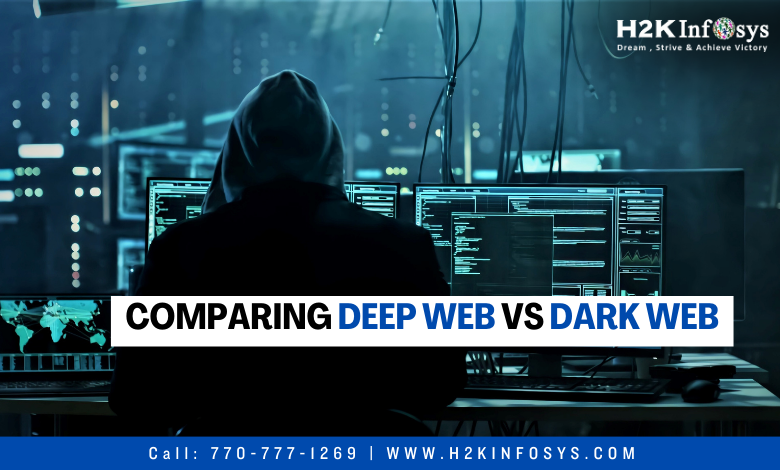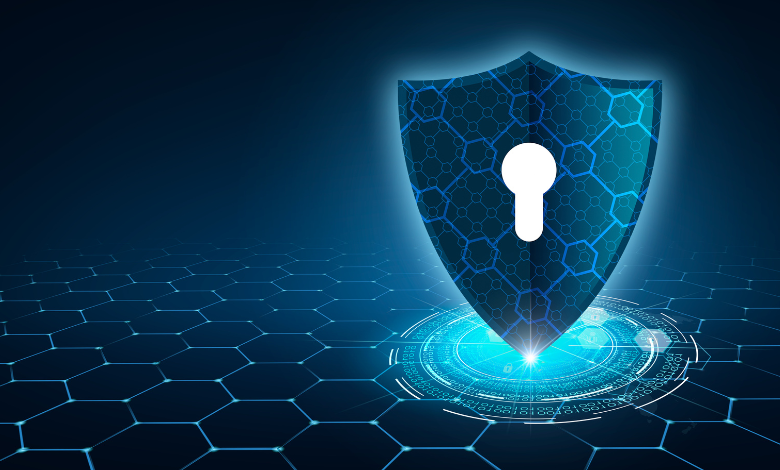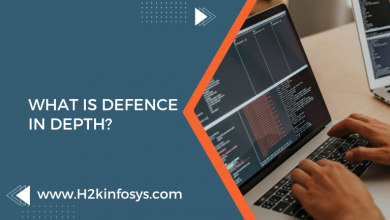Comparing Deep Web vs Dark Web

The Internet is vast, and the Surface Web, which can be found by search engines like Google and Bing, is just one part of it. The Deep and Dark Webs are utilised for distinct reasons and are located outside of the Internet’s publicly accessible areas. Check out our cyber security online course to learn more about Dark Web and Deep Web.
What is the Deep Web?
A portion of the Internet known as the “Deep Web” is unreachable through search engines yet accessible through standard web browsers. It is made up of “non-indexed” information, meaning that web crawlers (the tools that search engines like Google, Bing, and others use to locate and link to pages) cannot access it.
Deep Web pages are typically password-protected, login-only, paywall-protected, or otherwise private and access-limited. Deep Web pages are account pages on many websites and personal pages such as webmail inboxes. They also include websites that are protected by authentication and internal firm data that can be accessed online.
The Surface Web is dwarfed by the Deep Web. In actuality, the Deep Web contains 90–95% of the whole Internet, while the Surface Web only contains 10%–15% of it.
What is the Dark Web?
The portion of the Deep Web unavailable using standard web browsers is called the Dark Web. You need a browser that supports Tor in order to visit websites on the Dark Web. Furthermore, a lot of Dark Web sites can only be found using specialised search engines, by following links on other websites, or through word-of-mouth.
The main purpose of the Dark Web is to hide illicit activity. Dark Web markets facilitate the sale of illicit services, drugs, weapons, and credentials that have been stolen. Cybercriminal gangs also frequently gather on the Dark Web to plot their next move. Because of this, it’s also a great place to learn about new cybersecurity threats and data breaches.
But not all of the Dark Web is bad; in fact, the technology that powers it, Tor, was initially developed by the US government for acceptable objectives. Journalists, activists, whistleblowers, and other parties whose anonymity would be endangered or subject to censorship if they disseminated their work via conventional, non-anonymous websites are likewise protected by the Dark Web.
Differences Between the Deep Web and the Dark Web
Though it is technically a component of the Deep Web, there are some pretty substantial differences with the Dark Web. Among the most important are the following:
- Scope: The scope of the Deep Web surpasses that of the Dark Web and the Surface Web combined. Think about how every website’s private account page is a component of the Deep Web.
- Purpose: Though most Deep Web sites aren’t anonymous, their main purpose is to keep information private. Compared to the Deep Web, the Dark Web is more suitable for illicit activity because of its anonymous architecture.
- Access: The Deep Web can be accessed with standard web browsers even if search engines do not index it, that is, you can access your g-mail page with Firefox, Chrome, and other browsers. On the other hand, the Dark Web can only be accessed with specialised browsers that employ Tor to preserve anonymity.
Risks of Accessing the Deep Web and Dark Web
Both the Dark Web and the Deep Web have risks. The concerns on the Deep Web are mostly related to the fact that accessing private sites requires authentication and that these sites hold a lot of important and sensitive personal information. Cybercriminals will try to obtain your password or other credentials by phishing, social engineering, malware, and other methods if they are necessary to unlock this data.

However, the majority of the risk associated with the Dark Web comes from the content it hosts. The Dark Web is frequently utilised for illicit activity and entails the danger of malware infections, fraudulent schemes, and the exposure to objectionable or unlawful content.
Staying Safe on the Deep and Dark Web
Though they both have risks, using the Dark and Deep Web safely is possible. You may improve your online security and privacy by doing the following:
- Password Security: By using strong, distinct, and random passwords for every website, you lower the possibility that a hacked credential may grant access to several different online accounts.
- Endpoint Security: Preventing possible malware infections on a device can be achieved by utilising a reliable endpoint security solution.
- Install Updates: To prevent potential exploitation by fraudulent websites, install OS and browser updates as soon as possible.
- Use a VPN: By masking your IP address, a virtual private network (VPN) can help you browse the Dark Web anonymously.
- Use a Reputable Dark Web Browser: The Dark Web can be accessed using a variety of specialised browsers; therefore, to avoid possible malware, download one from a reliable website.
Conclusion
To learn more about the Deep Web and the Dark Web, check out our cyber security training online.





